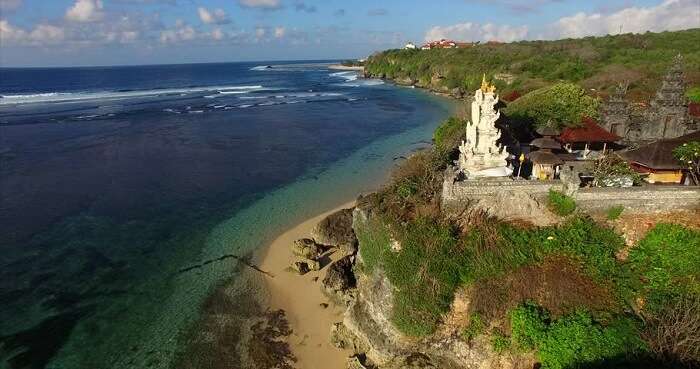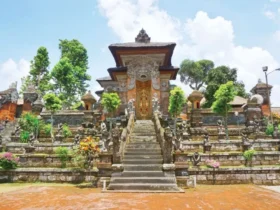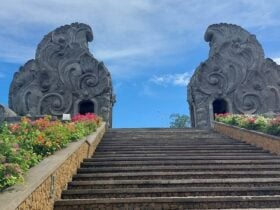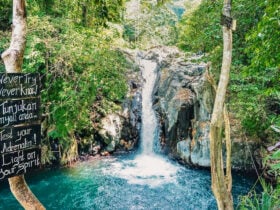Visiting Geger Temple Nusa Dua

Visiting Geger Temple Nusa Dua. Nestled along the peaceful shores of Nusa Dua, Bali, Pura Geger Dalem Pemutih, commonly known as Geger Temple, is a hidden spiritual gem that offers visitors a serene retreat from the more tourist-heavy areas of the island. Overlooking the turquoise waters of Geger Beach, this temple is not only a sacred site for the local Balinese Hindu community but also a place where travelers can connect with Bali’s rich cultural and spiritual heritage.
Geger Temple may not be as widely known as Bali’s larger temples, such as Tanah Lot or Uluwatu, but its quiet beauty and cultural significance make it a must-visit for those looking to experience a more intimate side of Balinese spirituality. Whether you’re exploring Nusa Dua’s luxurious resorts or seeking a quiet spot to reflect and take in the stunning coastal views, visiting Geger Temple offers a perfect blend of natural beauty and cultural immersion.
This article will guide you through everything you need to know about visiting Geger Temple, including its location, cultural significance, what to expect, and tips for making the most of your visit.
1. Location of Geger Temple

Geger Temple is located on a small cliff above Geger Beach, one of Nusa Dua’s most beautiful and serene stretches of coastline. The temple’s location is both tranquil and picturesque, offering panoramic views of the Indian Ocean and the pristine sands below. The lush, green surroundings and the sound of the waves crashing against the shore make this temple a peaceful retreat from the more bustling parts of Bali.
Getting to Geger Temple is relatively easy, especially if you’re staying in the Nusa Dua area. Many of the nearby resorts and hotels are just a short drive or walk away from the temple. If you’re coming from other parts of Bali, it’s about a 30-40 minute drive from the more central areas like Kuta, Seminyak, or Jimbaran.
Once you arrive at Geger Beach, you’ll find a path leading up to the temple. The short hike up the hill is worth the effort, as the views from the temple’s perch are truly breathtaking. The path is well-maintained, and as you ascend, you’ll be able to catch glimpses of the ocean through the trees, adding to the temple’s peaceful ambiance.
2. The Cultural and Spiritual Significance of Geger Temple
Like many temples in Bali, Pura Geger holds deep spiritual significance for the local Hindu community. The temple is dedicated to Dewi Saraswati, the Hindu goddess of knowledge, wisdom, music, and the arts. Saraswati is an important figure in Balinese Hinduism, and many offerings and prayers made at the temple are dedicated to seeking her blessings for knowledge, creativity, and success in life.
The temple is also considered a place of spiritual purification, where locals come to cleanse their minds and spirits through prayer and offerings. It’s a common sight to see worshippers dressed in traditional Balinese attire, carrying offerings of flowers, fruits, and incense as they make their way to the temple to seek blessings.
In addition to its dedication to Saraswati, Pura Geger is known as a temple of purification and healing. Many locals believe that the temple holds powerful energy, making it a place for spiritual rejuvenation and peace. The temple’s proximity to the ocean also ties into its spiritual significance, as water is considered a sacred element in Balinese Hinduism, symbolizing purification and the flow of life.
Although Geger Temple is primarily a place of worship for locals, visitors are welcome to explore the temple grounds and experience its spiritual atmosphere. However, it’s important to be respectful of the temple’s cultural significance and adhere to the guidelines for proper behavior when visiting.
3. The Architecture and Surroundings of Geger Temple
Geger Temple is a relatively small temple compared to some of Bali’s more famous sites, but what it lacks in size, it more than makes up for in beauty and serenity. The temple’s architecture is typical of traditional Balinese design, with intricately carved stonework, statues of deities, and shrines adorned with offerings. The temple’s ornate gates and stone steps create a sense of reverence as you approach the sacred site.
One of the most striking features of the temple is its location on a cliff overlooking the ocean. From the temple grounds, you can enjoy sweeping views of the sea and Geger Beach below. The temple’s perch gives it a sense of isolation and peace, making it an ideal spot for meditation or quiet reflection. The combination of the temple’s spiritual significance and its natural surroundings makes visiting Geger Temple a deeply moving experience for many.
The temple is surrounded by lush greenery, and the sound of the ocean provides a calming backdrop to the peaceful atmosphere. As you explore the temple grounds, you’ll find statues of Hindu deities and shrines adorned with colorful offerings, creating a vibrant contrast to the temple’s stone architecture.
4. What to Expect When Visiting Geger Temple

Visiting Geger Temple is a peaceful and reflective experience, making it an ideal stop for those looking to connect with Bali’s spiritual side. Unlike some of Bali’s more popular tourist attractions, Geger Temple is relatively quiet, allowing visitors to fully appreciate the temple’s tranquil setting and spiritual significance.
When you visit the temple, you’ll likely see locals dressed in traditional Balinese clothing, coming to the temple to make offerings and pray. It’s important to be respectful of the temple’s cultural significance and follow the guidelines for visiting. These include wearing appropriate attire, such as a sarong or scarf to cover your legs and shoulders, as well as refraining from loud or disruptive behavior.
While visitors are welcome to explore the temple grounds, the inner sanctum of the temple is reserved for worshippers only. However, the outer areas of the temple provide plenty of opportunities to admire the architecture, take in the stunning views, and soak in the spiritual atmosphere.
The best time to visit Geger Temple is in the morning or late afternoon when the temperatures are cooler, and the light is softer, making for great photography opportunities. The temple’s location on the coast means that the sunlight can create beautiful reflections on the ocean, especially during sunrise or sunset.
5. Geger Beach: A Perfect Spot to Unwind
One of the added bonuses of visiting Geger Temple is its proximity to Geger Beach, one of the most beautiful and serene beaches in Nusa Dua. After spending time at the temple, you can head down to the beach to relax, swim, or take a stroll along the soft, golden sands. Geger Beach is known for its calm, clear waters, making it a great spot for swimming or snorkeling.
The beach is relatively uncrowded compared to some of Bali’s more popular beaches, offering a peaceful retreat where you can unwind and enjoy the natural beauty of the coastline. There are also a few local warungs (small beachside cafés) where you can grab a refreshing drink or snack while taking in the ocean views.
For those looking to spend the day in the area, visiting Geger Temple followed by a relaxing afternoon on Geger Beach is the perfect way to experience the natural and spiritual beauty of Nusa Dua.
6. Tips for Visiting Geger Temple
To ensure that your visit to Geger Temple is respectful and enjoyable, here are a few tips to keep in mind:
- Dress Modestly: Like all Balinese temples, visitors to Geger Temple are required to dress modestly. It’s recommended to wear a sarong or scarf to cover your legs and shoulders. Sarongs are often available for rent or purchase near the temple entrance if you don’t have one with you.
- Be Respectful of Worshippers: Geger Temple is an active place of worship, so it’s important to be mindful of those who are there to pray. Avoid loud conversations or disruptive behavior, and give worshippers space to make their offerings.
- Best Time to Visit: The temple is open throughout the day, but the best time to visit is early in the morning or late in the afternoon when the light is soft, and the temperature is cooler. Sunrise and sunset are particularly beautiful times to experience the temple’s peaceful atmosphere.
- Photography: While photography is allowed in the outer temple areas, it’s important to be respectful and avoid taking photos of worshippers or the inner sanctum. The views from the temple grounds provide excellent photo opportunities, especially with the ocean as a backdrop.
- Combine with a Beach Visit: After exploring the temple, head down to Geger Beach to relax and enjoy the calm waters. The combination of a spiritual visit and a beach retreat makes for a perfect day in Nusa Dua.
Geger Temple in Nusa Dua offers a peaceful and spiritual retreat for those looking to experience the quieter side of Bali. With its stunning location overlooking Geger Beach and its deep cultural significance, the temple provides visitors with a unique opportunity to connect with Bali’s spiritual heritage while enjoying the natural beauty of the island.
Whether you’re seeking a place for quiet reflection, exploring Bali’s temples, or simply looking for a beautiful spot to visit, Geger Temple is a must-see destination that embodies the serene and sacred atmosphere that Bali is known for. Combined with a visit to the nearby beach, it makes for a memorable and enriching experience in the heart of Nusa Dua.










Leave a Review